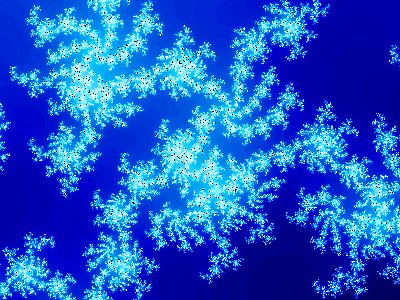(c) Robert Neil Boyd
 |
 Non-Linear Fractals (R. N. Boyd)
Non-Linear Fractals (R. N. Boyd)
Hyperdimensional Fractals (R. N. Boyd)
Chaos in Periodically Perturbed Monopole + Quadrupole Like Potentials (P.S. Letelier, W.M. Vieira)
Evolutionary Networks and Nature -- 7 Sep 2001 S.N. Dorogovtsev and J.F.F. Mendes (Submitted to Advances in Physics on 6th March 2001) We review the recent fast progress in statistical physics of evolving networks. Interest has focused mainly on the structural properties of random complex networks in communications, biology, social sciences and economics. A number of giant artificial networks of such a kind came into existence recently. This opens a wide field for the study of their topology, evolution, and complex processes occurring in them. Such networks possess a rich set of scaling properties. A number of them are scale-free and show striking resilience against random breakdowns. In spite of large sizes of these networks, the distances between most of their vertices are short -- a feature known as the "small-world" effect. We discuss how growing networks self-organize into scale-free structures and the role of the mechanism of preferential linking. We consider the topological and structural properties of evolving networks, and percolation in these networks. We present a number of models demonstrating the main features of evolving networks and discuss current approaches for their simulation and analytical study. Applications of the general results to particular networks in Nature are discussed. We demonstrate the generic connections of the network growth processes with the general problems of non-equilibrium physics, econophysics, evolutionary biology, etc.
Tiling spaces are Cantor set fiber bundles (Lorenzo Sadun, R. F. Williams) -- We prove that fairly general spaces of tilings of R^d are fiber bundles over the torus T^d, with totally disconnected fiber. This was conjectured (in a weaker form) in [W3], and proved in certain cases. In fact, we show that each such space is homeomorphic to the d-fold suspension of a Z^d subshift (or equivalently, a tiling space whose tiles are marked unit d-cubes). The only restrictions on our tiling spaces are that 1) the tiles are assumed to be polygons (polyhedra if d>2) that meet full-edge to full-edge (or full-face to full-face), 2) only a finite number of tile types are allowed, and 3) each tile type appears in only a finite number of orientations. The proof is constructive, and we illustrate it by constructing a ``square'' version of the Penrose tiling system.